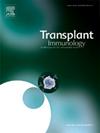Determining the best premedication regimen to prevent rabbit anti-human thymocyte globulin infusion-associated reactions: A retrospective study comparing two hematopoietic stem cell transplant centers
IF 1.4
4区 医学
Q4 IMMUNOLOGY
引用次数: 0
Abstract
Background
Thymoglobulin® (ATG), a rabbit anti-human thymocyte globulin, is used in allogeneic hematopoietic stem cell transplantation (HSCT) mainly to prevent the development of graft-versus-host disease (GVHD). Three doses (ATG1, ATG2, and ATG3) are administered on separate days, apart from the graft day. Since infusion-associated reactions (IAR) are frequent, patients were treated with acetaminophen, antihistamine, and corticosteroids (CS) as premedication (PR); however, the best PR regimen remains to be defined.
Methods
The study compared the incidence and severity of IAR related to ATG according to the different PR therapy. This descriptive retrospective cohort study included patients receiving ATG in two HSCT transplant centers (Hospitals A and B). The data cut-off was in March 2020, but the period of interest was different between the two hospitals to balance the two groups. Four PR regimens were compared, one from Hospital A (PR-A) and three from Hospital B (PR-B1, B2, and B3), which have changed twice in the last decade. Along with PR therapy, the indication and method of administration of ATG also differed between hospitals.
Results
A total of 132 patients were included from May 2011 to March 2020. Groups PR-A, B1, B2, and B3 had, respectively, 61, 22, 26, and 23 patients. Of them, 115 (87 %) had at least one IAR, and 86 (65 %) had at least one severe IAR during any ATG infusions. ATG3 had the lowest incidence of IAR (39 %), and it seemed better tolerated when given after graft infusion than before (32 % vs. 46 %, respectively; p = 0.11). Almost three-quarters of patients had at least one IAR that occurred after the end of an ATG infusion, but there was less IAR with PR-B3 protocol where acetaminophen and diphenhydramine were regularly administered beyond ATG infusion. Hospital A used a progressive rate of infusion, but early IAR was seen compared to Hospital B (p = 0.03), where a fixed rate was used. No direct association was found between the CS dose received and IAR incidence (p = 0.21) or severity (p = 0.61). However, there was a recurrent signal for less severe IAR in the PR-B3 group compared to its predecessors, B1 and B2 groups (p = 0.12), and the key difference was an increased CS dose. The mean total CS therapy received was nearly double at Hospital A compared with Hospital B (1182 vs. 692 mg prednisone equivalent; p < 0.01). Fungal infection rate was higher in Hospital A compared to Hospital B (33 % vs. 13 %; p < 0.01). The infection rate correlated with a higher dose of CS received on days of ATG therapy (p < 0.01).
Conclusion
ATG3 given the day after HSCT appears to play a key role in reducing the incidence and severity of IAR. Infusion over six hours at a fixed rate was safe. Frequent, regular, and extended doses of acetaminophen and antihistamines beyond ATG infusion appear useful. Increasing CS doses led to IAR reduction, but this correlated with an increased infection rate.
确定预防兔抗人胸腺细胞球蛋白输注相关反应的最佳用药前方案:一项比较两个造血干细胞移植中心的回顾性研究
胸腺球蛋白(thymoglobulin®,ATG)是一种兔抗人胸腺细胞球蛋白,用于异体造血干细胞移植(HSCT),主要用于预防移植物抗宿主病(GVHD)的发生。三剂(ATG1, ATG2和ATG3)在移植日以外的不同天给药。由于输注相关反应(IAR)频繁发生,患者使用对乙酰氨基酚、抗组胺药和皮质类固醇(CS)作为预用药(PR);然而,最佳的公关方案仍有待确定。方法根据不同的PR治疗方法,比较ATG相关IAR的发生率和严重程度。这项描述性回顾性队列研究纳入了两家HSCT移植中心(A医院和B医院)接受ATG的患者。数据截止日期为2020年3月,但两家医院的研究期不同,以平衡两组的差异。比较了四种PR方案,一种来自A医院(PR-A),三种来自B医院(PR- b1, B2和B3),在过去十年中改变了两次。在PR治疗的同时,不同医院间ATG的适应症和给药方法也存在差异。结果2011年5月至2020年3月共纳入132例患者。PR-A组、B1组、B2组、B3组患者分别为61例、22例、26例、23例。其中115例(87%)至少发生一次IAR, 86例(65%)在任何ATG输注期间至少发生一次严重IAR。ATG3的IAR发生率最低(39%),并且在移植物输注后给予ATG3似乎比移植物输注前耐受性更好(分别为32%对46%;p = 0.11)。几乎四分之三的患者在ATG输注结束后至少发生一次IAR,但PR-B3方案中,在ATG输注后定期给予对乙酰氨基酚和苯海拉明,IAR较少。A医院采用渐进输注速率,但与B医院相比,早期IAR出现(p = 0.03), B医院采用固定速率。接受CS剂量与IAR发生率(p = 0.21)或严重程度(p = 0.61)之间未发现直接关联。然而,与先前的B1和B2组相比,PR-B3组存在较轻IAR的复发信号(p = 0.12),关键差异在于CS剂量的增加。A医院接受的平均总CS治疗几乎是B医院的两倍(1182毫克对692毫克强的松当量;p & lt;0.01)。A医院的真菌感染率高于B医院(33%比13%;p & lt;0.01)。感染发生率与ATG治疗天数的高剂量CS相关(p <;0.01)。结论HSCT后1天给予atg3对降低IAR的发生率和严重程度起关键作用。以固定速率注射超过6小时是安全的。除ATG输注外,频繁、定期和延长剂量的对乙酰氨基酚和抗组胺药似乎是有用的。增加CS剂量导致IAR减少,但这与感染率增加相关。
本文章由计算机程序翻译,如有差异,请以英文原文为准。
求助全文
约1分钟内获得全文
求助全文
来源期刊

Transplant immunology
医学-免疫学
CiteScore
2.10
自引率
13.30%
发文量
198
审稿时长
48 days
期刊介绍:
Transplant Immunology will publish up-to-date information on all aspects of the broad field it encompasses. The journal will be directed at (basic) scientists, tissue typers, transplant physicians and surgeons, and research and data on all immunological aspects of organ-, tissue- and (haematopoietic) stem cell transplantation are of potential interest to the readers of Transplant Immunology. Original papers, Review articles and Hypotheses will be considered for publication and submitted manuscripts will be rapidly peer-reviewed and published. They will be judged on the basis of scientific merit, originality, timeliness and quality.
 求助内容:
求助内容: 应助结果提醒方式:
应助结果提醒方式:


